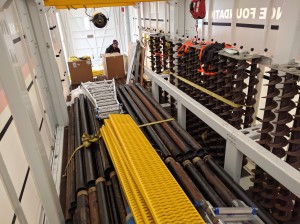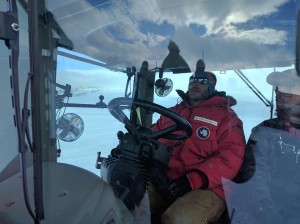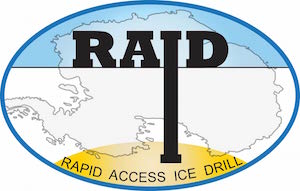
Inside the drill-rod module. Auger flights used for cutting the firn in cassettes along the wall, and the main drill rods (pipe) stacked on the floor. Yellow decking is for catwalks.
We’ve now been deploying people to ‘the ice’ in stages over the past few week. First the initial drill engineering group made it to Antarctica in late October, followed by a couple more of the drilling crew, and finally the rest of will arrive on the ice by November 23rd, the same day the traverse group is set to launch from McMurdo. It should take them 2-3 days to drive out to Minna Bluff and start setting up the camp for the season and get the drilling equipment into position. The rest of us will fly out by helo on December 1. If all goes well, we will have the rest of December to run RAID through its paces.
RAID is designed as a mobile system that can operate autonomously by traversing with tractors over long distances (hundreds of kilometers at a time). All we need is a supply of diesel fuel! But RAID was designed to carry enough fuel and drilling fluid to make up to 6 deep ice boreholes in a single season, each spaced 10s or 100s of kilometers apart. From a base at South Pole, we will have access to many areas of the central Antarctic ice cap. On the plateau of the East Antarctic ice sheet, things will be challenging because of high altitude (mostly over 6,000 feet), cold temperatures (from -50 to -20 °C), high wind, and ultra-dry air. These conditions will be hard on both people and equipment.

Rich learning to drive a tractor.
As if that wasn’t enough, the surface varies from soft, deep snow to barren ‘blue’ ice to wind-blown ‘sastrugi’, which are like small dunes of hard-packed snow. Driving over these features and in these conditions will require experienced traverse drivers. But the RAID modules, especially the drill and rod modules, are constructed of tough Arctic-rated steel that should allow us to move over any surface. Plus a new ski design with a built-in lever arm will give each unit helpful flexibility. Although our field trials this season near Minna Bluff won’t see anything like the severe conditions of the polar plateau, it will be a good overall test of our ability to work in Antarctic conditions.
Getting the RAID modules out to open snow on the ice shelf prior to moving to Minna Bluff is itself a bit of a trick, because after spending the winter onshore at McMurdo Station, they had to be first mounted on skis by crane, and then pulled across the ‘transition’ from firm ground of the station to the sea ice and then the ice shelf. Sea ice is both a blessing and a curse for McMurdo – proximity to annual sea ice makes McMurdo the highest latitude marine port in Antarctica, but it also means that once the sea ice starts to break up each summer, the boundary between land and water becomes more and more difficult to cross. The transition is infamous for being rough, mushy, and subject to tidal changes. It is commonly impassible, especially by mid-summer in late December and January. Fortunately, our engineers and station staff were able to get all of our units across the transition onto firm ice and out past Williams air field without difficulty. A video (link below) of the modules being moved across the sea ice to Willy Field shows that we can move at a decent clip under these ideal, smooth conditions. It’s good for now, but we don’t expect that traversing on the high plateau will be a cake-walk!
If you like these blog posts, share them by your social media to let other people know, and follow us on Facebook and Twitter!
